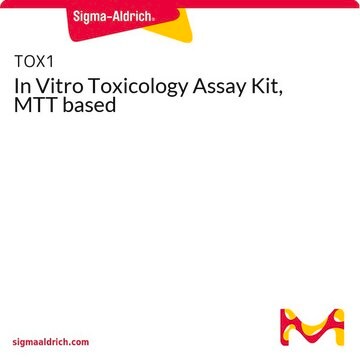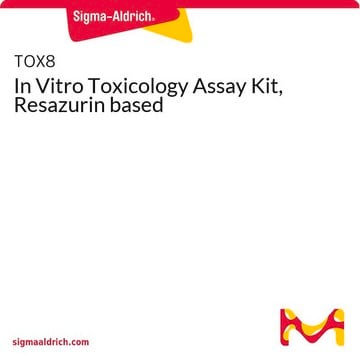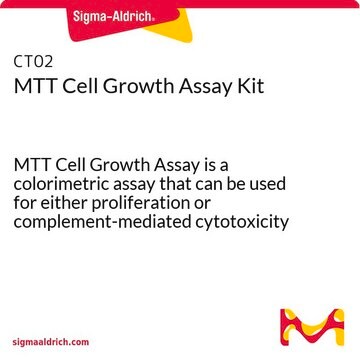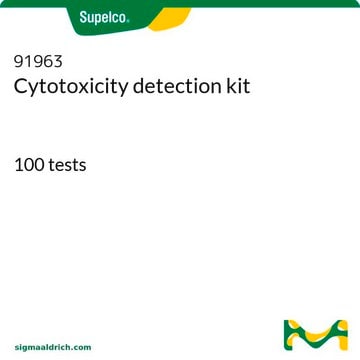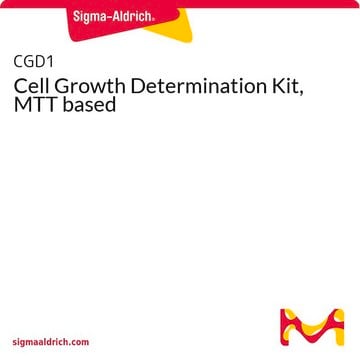TOX7
In Vitro Toxicology Assay Kit, Lactic Dehydrogenase based
Synonym(s):
LDH cytotoxicity assay
Sign Into View Organizational & Contract Pricing
All Photos(1)
About This Item
UNSPSC Code:
12352207
NACRES:
NA.84
Recommended Products
form
liquid
usage
kit sufficient for 500 tests
packaging
pkg of 1 kit
storage condition
dry at room temperature
technique(s)
protein quantification: suitable
λmax
490 nm
application(s)
cell analysis
detection
detection method
colorimetric
storage temp.
−20°C
General description
Tox7 is a member of Sigma′s CytoToxicity Kit series. It is based on the measurement of lactate dehydrogenase (LDH) release from cells as a measure of cell membrane damage and cytotoxicity. This technique has been utilized as an alternative to 51Cr release for cell mediated cytotoxicity assays, as well as conventional cytotoxicity resulting from interaction of a test material with the cell.
Application
In Vitro Toxicology Assay Kit, Lactic Dehydrogenase based has been used:
- to detect lactate dehydrogenase release in human umbilical vein endothelial cells (HUVECs) and human cardiac myocytes (HCMs) for lactate dehydrogenase (LDH) assay
- to determine the activity of lactate dehydrogenase leakage of MDA-MB-231 cells
- to examine the activity of LDH in RAW 264.7 cells , in LDH cytotoxicity assay in human cell lines
- for spectrophotometric measurement of viable cells. Absorbance of converted dye is measured at a wavelength of 490 nm.
Biochem/physiol Actions
The lactate dehydrogenase assay is a means of measuring either the number of cells via total cytoplasmic lactate dehydrogenase (LDH) or membrane integrity as a function of the amount of cytoplasmic LDH released into the medium. This method is simple, accurate and yields reproducible results. The assay is based on the reduction of NAD by LDH. The resulting reduced NAD (NADH) is utilized in the stoichiometric conversion of a tetrazolium dye to a soluble, colored formazan derivative.
.
.
Hazard Statements
Precautionary Statements
Hazard Classifications
Aquatic Chronic 3
Storage Class Code
10 - Combustible liquids
Certificates of Analysis (COA)
Search for Certificates of Analysis (COA) by entering the products Lot/Batch Number. Lot and Batch Numbers can be found on a product’s label following the words ‘Lot’ or ‘Batch’.
Already Own This Product?
Find documentation for the products that you have recently purchased in the Document Library.
Customers Also Viewed
Katarzyna Walczak et al.
International journal of molecular sciences, 21(21) (2020-10-30)
Tryptophan metabolites: kynurenine (KYN), kynurenic acid (KYNA) and 6-formylindolo[3,2-b]carbazole (FICZ) are considered aryl hydrocarbon receptor (AhR) ligands. AhR is mainly expressed in barrier tissues, including skin, and is involved in various physiological and pathological processes in skin. We studied the
Effects of 5-fluorouracil on morphology, cell cycle, proliferation, apoptosis, autophagy and ROS production in endothelial cells and cardiomyocytes
Focaccetti C, et al.
Testing, 10, e0115686-e0115686 (2015)
Christian Polley et al.
Materials (Basel, Switzerland), 13(7) (2020-04-15)
The prevalence of large bone defects is still a major problem in surgical clinics. It is, thus, not a surprise that bone-related research, especially in the field of bone tissue engineering, is a major issue in medical research. Researchers worldwide
Cytotoxicity of biologically synthesized silver nanoparticles in MDA-MB-231 human breast cancer cells
Gurunathan S, et al.
BioMed Research International (2013)
Chia-Hui Lin et al.
International journal of molecular sciences, 21(7) (2020-04-12)
Since their invention, periodic mesoporous organosilicas (PMOs), an innovative class of materials based on organic as well as inorganic hybrid nanocomposites, have gathered enormous interest owing to their advantageous physicochemical attributes over the pristine mesoporous silica nanoparticles (MSNs). To further
Our team of scientists has experience in all areas of research including Life Science, Material Science, Chemical Synthesis, Chromatography, Analytical and many others.
Contact Technical Service



